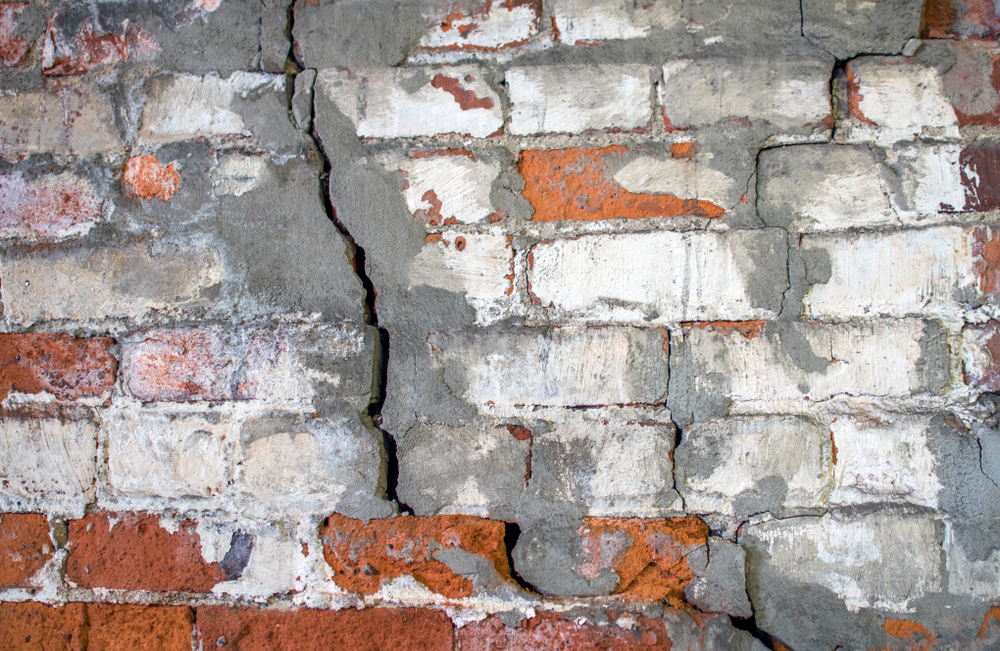Facilities professionals should regularly inspect the inside and outside of their commercial properties to look for problems with their foundations. Keep in mind that commercial foundations are built differently than residential foundations so they can support the weight of the structure.

According to Forbes, commercial property foundations can fail because of saturated or frozen soil and exposed subsoil, mold, and mildew.
To prevent commercial property foundation failure, facilities professionals should look out for these 10 warning signs:
1. Foundation and Exterior Wall Cracks
One of the first signs of foundation failure is exterior cracks. Hairline cracks aren’t necessarily a cause for alarm, but large cracks that have a zigzag pattern and grow rapidly in your facility’s foundation or exterior walls can be a more serious problem. The New York City Department of Buildings recommends looking for masonry that moves outward or downward, water stains, and diagonal cracks.
2. Interior Wall Cracks
Cracks can be indicative of excessive stress on building materials because of heat and cold or the deterioration of materials. Like with exterior walls, be aware of large cracks. Vertical cracks, which run up and down the walls, can indicate the building is settling and can be fixed. Horizontal cracks, on the other hand, are more problematic and can indicate localized support failure.
3. Warped Floors
Do your floors look warped, cracked, uneven, or saggy? Facilities professionals should fix this immediately to prevent slip, trip, or fall hazards. Learn more by reading “Back to Basics: Slips, Trips, and Falls” on EHS Daily Advisor. Uneven floors are also a possible foundation problem. To determine whether the floor is even, use a golf or tennis ball.
4. Sticking Doors
Doors can stick, or be unable to lock, for a variety of reasons, including loose hardware, a sagging frame, dirt in the hinges, warped wood, or humidity, so consider replacing screws and hinges. However, if you notice multiple doors have this problem year-round or if you see the door frame pulling away from the wall, it could be a problem with your foundation.
5. Sticking Windows
Just like sticking doors, sticking windows, or windows that won’t lock, can occur for the same reasons, especially in old buildings. Windows can also stick due to problems with caulking, sealants, or a damaged frame, and the wood around the windows can crack due to moisture. Additionally, dirt, debris, or rust can prevent a window from moving. But if all the sticking windows are along the same wall, it could be a foundation problem.
6. Separating Fixtures
Have you seen molding, built-in bookshelves, cabinets, or backsplashes separate from the wall? Is your patio separated from the stairs or the building itself? Temperature changes can cause these problems. However, if the gap keeps getting wider between the wall and what it’s attached to, there might be an issue with the facility’s foundation.
7. Gaps
Gaps between the wall and ceiling and gaps between the wall and the floor are sometimes caused by the natural settlement of the building, the expansion and contraction of building materials, or even improper installation during the construction process. However, if left unattended and if they become larger, these gaps can create further damage and safety issues because of severe foundation problems.
8. Sagging Walls and Ceilings
Seasonal temperature changes, poorly installed drywall, or water damage can cause sagging ceilings and walls, which can also be caused by misaligned load-bearing walls and long-spanning floor and ceiling joints. While roof leaks and age can cause these damages, walls and ceilings that are sagging significantly could indicate an issue with the foundation.
9. Plumbing Issues
Be sure to monitor your commercial facility’s water bill for unusual changes, remind tenants to report plumbing leaks, and have regular plumbing inspections. A lack of proactive maintenance, the failure to fix septic issues, excessive water pressure, and the poor installation of pipes can create hidden pipe leaks, which can affect the soil under the foundation.
10. Standing Water
Check around your facility for areas of standing water, which can collect due to runoff from sloped landscaping and natural runoff from nearby bedrock. Also, remove debris from around the foundation, and ensure gutter downspouts aren’t washing away soil around the building, which could harm the foundation.
Solution
If you think you have a problem with your facility’s foundation, contact a foundation repair specialist right away for an inspection. If you delay, the problem will likely become more difficult and expensive to fix.
